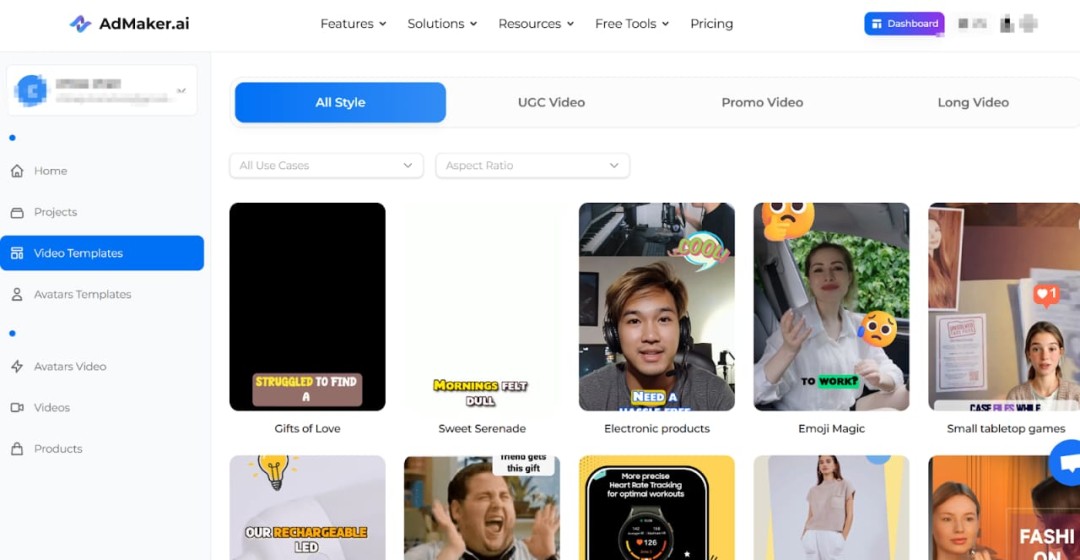
Artificial intelligence is redefining the creative frontiers of modern marketing. From hyper-personalized video content to fully automated ad production, AI is not only accelerating efficiency but also unlocking new realms of innovation. In this guide, we explore two cutting-edge tools at the forefront of this transformation: arting.ai for video face swapping and admaker.ai for intelligent ad creation—equipping marketers with the strategic insights needed to thrive in an AI-driven landscape.
Video Face Swap Technology: Redefining Personalized Marketing ContentTechnical Framework and Application Scenarios
Video face swap technology represents the latest breakthrough in AI video processing capabilities. This technology utilizes deep learning algorithms to analyze facial features, expression dynamics, and lighting conditions in real-time, achieving natural and seamless face replacement effects.
In marketing applications, video face swap technology provides brands with unprecedented personalized content creation capabilities:
Brand Ambassador Localization: Multinational brands can utilize unified creative scripts while employing face swap technology to feature local spokespersons from different regions in identical video content, maintaining brand consistency while achieving cultural localization.
Product Demonstration Personalization: E-commerce platforms and brand merchants can create personalized product demonstration videos, allowing potential customers to visualize themselves using products, significantly improving conversion rates and user engagement.
Customer Case Study Video Production: B2B enterprises can create more compelling case study videos while protecting client privacy by using professional actors to replace actual customers in product usage scenarios.
Implementation Strategies and Best Practices
Successfully applying video face swap technology requires adherence to the following key principles:
Content Strategy Planning: Before implementing face swap technology, marketing teams must clearly define content objectives, audience positioning, and brand tonality. Technology should serve marketing strategy rather than become the marketing objective itself.
Quality Control Standards: Establish rigorous output quality assessment systems to ensure generated video content meets professional standards in facial expression naturalness, color consistency, and motion synchronization.
Compliance Considerations: Develop clear usage guidelines ensuring all face swap content usage obtains necessary authorizations and complies with relevant legal regulations and platform policies.
A/B Testing Optimization: Through comparative analysis of traditional video content versus face swap-generated content performance data, continuously optimize creative strategies and technical parameter settings.
Advanced Application Techniques
Multi-language Market Adaptation: Combined with voice synthesis technology, not only can facial replacement be achieved, but synchronized adaptation of lip movements for different languages can also be accomplished, providing truly multilingual video content solutions for global brands.
Real-time Interactive Marketing: In live streaming marketing scenarios, utilize real-time face swap technology to enable virtual interactions between viewers and brand spokespersons, creating immersive brand experiences.
Seasonal Content Rapid Iteration: Through preset face swap templates, quickly generate video content adapted to different seasons, holidays, or marketing campaigns, significantly reducing content production cycles.
Intelligent Advertisement Creation: Data-Driven Creative AutomationCore Value Proposition of AI Ad Creation Platforms
AI ad maker platforms represent the cutting edge of advertising production automation. These platforms utilize machine learning algorithms to analyze vast amounts of successful advertising cases, extracting design patterns, color coordination principles, and copywriting structural models to provide users with intelligent advertising creation services.
The core advantages of modern AI advertisement creation tools manifest across several dimensions:
Design Intelligence: Systems can automatically generate advertisement designs that comply with visual hierarchy principles based on brand colors, industry characteristics, and target audience preferences, ensuring every advertisement element follows data-validated arrangement logic.
Content Personalization: Based on user behavior data and preference analysis, generate personalized advertising content tailored to different audience segments, improving advertisement relevance and conversion effectiveness.
Multi-channel Adaptation: One-click generation of advertisement sizes and formats adapted to different platform requirements, from social media news feeds to search engine display advertisements, achieving comprehensive channel coverage.
Performance Prediction Optimization: Utilizing predictive models trained on historical data, potential performance can be evaluated before advertisement publication, providing data support for optimization decisions.
Practical Application Framework
Data Input Optimization: To achieve optimal creative results, marketing teams need to provide high-quality input data to AI systems, including accurate brand guidelines, clear product information, and explicit marketing objectives.
Creative Direction Setting: While AI can automatically generate creative content, human-set creative directions and brand tonality remain crucial. Marketing professionals must find the balance between automation and brand consistency.
Iterative Optimization Process: Establish continuous improvement mechanisms based on data feedback, adjusting AI system parameter settings and creative strategies according to actual advertisement performance data.
Quality Review System: Even AI-generated content requires human review to ensure all outputs comply with brand standards, legal requirements, and platform policies.
Advanced Strategic Applications
Dynamic Creative Optimization (DCO): Combined with real-time data feedback, AI advertisement creation platforms can automatically adjust advertisement elements including images, copy, colors, and layouts, achieving true dynamic optimization.
Competitive Analysis Integration: Through analysis of competitor advertising strategies and performance data, AI systems can generate differentiated creative solutions, helping brands stand out in competition.
Seasonal and Trend Adaptation: Intelligent systems can identify seasonal trends and trending topics, automatically adjusting advertisement content to maintain timeliness and relevance.
Multivariate Testing Automation: AI platforms can simultaneously generate dozens of advertisement variants, automatically conduct multivariate testing, quickly identify optimal combinations, and implement scalable applications.
Integrated Applications: Building AI-Driven Marketing EcosystemsMaximizing Synergistic Effects
Combining video face swap technology with intelligent advertisement creation platforms can create significant synergistic effects. Marketing teams can first determine optimal creative directions and visual elements through AI advertisement creation platforms, then utilize video face swap technology to produce personalized video advertisement content.
This integrated application model is particularly suitable for the following scenarios:
Multi-market Promotional Campaigns: Using unified creative frameworks and localized video content to achieve perfect balance between global consistency and local relevance.
Product Launch Marketing: Rapidly generating numerous creative variants, finding optimal solutions through A/B testing, then utilizing video technology for scalable personalized production.
Customer Journey Marketing: Using different AI tool combinations at various stages of the customer journey, from awareness-stage advertisement creation to conversion-stage personalized video content.
Data-Driven Decision Optimization
Successful AI marketing strategies must be built on data-driven decision foundations. Marketing teams need to establish comprehensive data collection and analysis systems:
Performance Metrics Tracking: Establish comprehensive evaluation systems including click-through rates, conversion rates, engagement levels, and brand awareness metrics.
User Feedback Loops: Through user research, social media listening, and customer service feedback, understand user acceptance of AI-generated content.
Cost-Benefit Analysis: Regularly evaluate return on investment from AI tool usage, including time savings, quality improvements, and conversion effect enhancements across multiple dimensions.
Technology Development Tracking: Maintain awareness of AI technology development trends, timely evaluation and adoption of new functions and capabilities.
Future Trends and Development ProspectsTechnology Integration Deepening
Future AI marketing tools will demonstrate stronger technological integration characteristics. Video face swap technology will deeply integrate with voice synthesis, emotion analysis, and behavior prediction technologies, creating more intelligent and personalized marketing solutions.
Intelligent advertisement creation platforms will also integrate more advanced functions, including real-time market trend analysis, automated media purchasing, and cross-platform effect optimization capabilities.
Application Scenario Expansion
As technology maturity improves, application scenarios for these AI tools will continuously expand:
Virtual Influencer Marketing: Brands can create completely AI-generated virtual spokespersons, achieving more flexible brand image management.
Immersive Experience Marketing: Combined with AR/VR technology, create more immersive brand experiences.
Real-time Personalized Marketing: Based on user real-time behavior data, dynamically generate personalized marketing content.
Industry Standards Establishment
With the widespread adoption of AI marketing tools, industry standards and best practices will gradually be established, including technical standards, ethical guidelines, and quality assessment systems across multiple levels.
Advanced Analytics and Performance OptimizationPredictive Analytics Integration
Customer Behavior Modeling: Leverage AI tools' data generation capabilities to build sophisticated customer behavior prediction models, enabling proactive campaign adjustments and personalized content delivery strategies.
Market Trend Forecasting: Utilize accumulated performance data to identify emerging market trends and consumer preferences, informing strategic decision-making processes and competitive positioning.
ROI Optimization Models: Develop advanced return on investment calculation models that account for both direct and indirect benefits of AI tool implementation, including efficiency gains, quality improvements, and strategic advantages.
Cross-Platform Performance Analysis
Omnichannel Attribution: Implement comprehensive attribution models that accurately measure AI-generated content performance across multiple marketing channels and touchpoints.
Audience Segmentation Refinement: Continuously refine audience segmentation strategies based on AI tool performance data, identifying high-value customer segments and optimizing targeting approaches.
Creative Performance Benchmarking: Establish industry-specific performance benchmarks for AI-generated content, enabling competitive analysis and strategic positioning assessments.
Industry-Specific Applications and Use CasesB2B Marketing Applications
Sales Enablement Content: Utilize AI tools to create personalized sales presentation materials and product demonstrations tailored to specific client needs and industry verticals.
Thought Leadership Content: Develop scalable thought leadership content strategies using AI tools while maintaining authentic brand voice and industry expertise positioning.
Account-Based Marketing Enhancement: Implement AI-driven personalization strategies for account-based marketing campaigns, creating highly targeted content for key prospect accounts.
E-commerce and Retail Applications
Product Showcase Optimization: Leverage video face swap technology to create diverse product demonstration content featuring various demographic representations without extensive production costs.
Seasonal Campaign Automation: Develop automated seasonal and promotional content generation processes that rapidly adapt to changing market conditions and inventory requirements.
Customer Review Integration: Transform customer testimonials and reviews into compelling video content using AI face swap technology while maintaining authenticity and trust.
Entertainment and Media Applications
Content Localization Strategies: Implement scalable content localization processes for global entertainment properties, adapting marketing materials for different cultural contexts and regional preferences.
Influencer Partnership Enhancement: Extend influencer partnership value through AI-enhanced content creation, maximizing campaign reach and engagement across multiple platforms.
Audience Engagement Innovation: Develop innovative audience engagement strategies using AI tools to create interactive and personalized entertainment experiences.
Future-Proofing Marketing StrategiesEmerging Technology Integration
Augmented Reality Convergence: Prepare for integration opportunities between AI marketing tools and emerging AR/VR technologies, positioning organizations for next-generation marketing experiences.
Voice Technology Integration: Develop strategies for incorporating voice synthesis and audio AI capabilities alongside visual AI tools, creating comprehensive multimedia marketing solutions.
Blockchain and Verification Technologies: Explore integration possibilities with blockchain-based verification systems for AI-generated content authentication and intellectual property protection.
Competitive Advantage Sustainability
Proprietary Data Leverage: Develop strategies for leveraging proprietary customer and performance data to create unique competitive advantages through AI tool customization and optimization.
Innovation Pipeline Management: Establish systematic processes for evaluating and adopting emerging AI marketing technologies, maintaining competitive positioning in rapidly evolving markets.
Strategic Partnership Development: Build strategic relationships with AI technology providers and industry innovators to access advanced capabilities and influence technology development directions.
Conclusion: Mastering the AI Marketing Revolution
AI is reshaping marketing—from experimentation to real-world application. Tools like video face swap and intelligent ad platforms empower marketers with new creative capabilities and enhanced efficiency.
Adopting AI is not just a tech upgrade—it’s a rethinking of how marketing teams operate, innovate, and lead.
Media Contact
Company Name: Arting.AI
Contact Person: Mark Davis
Email: Send Email
City: New York
Country: United States
Website: https://arting.ai/





